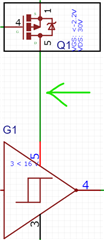Other Parts Discussed in Thread: INA3221, TPS25947, TPS25200-Q1, TPS25940, , TPS2596
Hi Team,
Can you please help us regarding the customer's inquiry below.
The application of the eFUSE is as follows: I will apply the eFUSE on the VDD pin of my schmitt trigger inverter of my reset circuit. In case of a singe event latchup, the eFUSE will cutoff the overcurrent phenomenon; hence, saving the schmitt inverter from the overcurrent surge and stopping the singe event latchup. For the eFUSE to do its role, I need to pick the correct resistors for IMON pin and ILIM pin.
This is where I get confused with the equations. While I understand that R(ILIM) is for the overcurrent protection, I also intend to use the IMON pin to monitor the current.
There are 3 equations for calculating the R(IMON) as found in the datasheet: equation 5, equation 13, and equation 36. For me, these 3 equations kind of contradict each other.
Equation 36 seems like the most straightforward equation for my application, but it excludes ILIM which sets up the overcurrent threshold. Shouldn't ILIM be excluded for overcurrent protection? Furthermore, equation 36 has PGTH pin connected to IMON pin. Why do this when the device will not shutdown if PGTH > V(PGTHR)? The datasheet doesn't EXPLICITLY indicate device shutdown if PGTH > V(PGTHR), only PGOOD pin is asserted high.
For equation 13, why does the voltage range of the ADC matter when in Equation 36 it doesn't? Furthermore, why does equation 13 includes ILIM but equation 36 doesn't?
For equation 5, why is the numerator based on the V(IN) but equation 13 numerator is based on ADC voltage range?
These are all confusing to think about. Please help me in choosing which equation to follow for my IMON pin.
For my application of overcurrent protection, do I really need to connect PGTH to IMON? Will the device shutdown during overcurrent if PGTH is connected to IMON?
Regards,
Danilo


